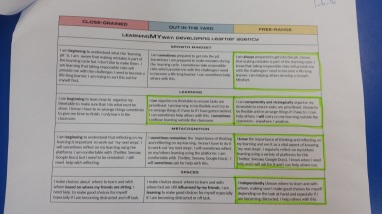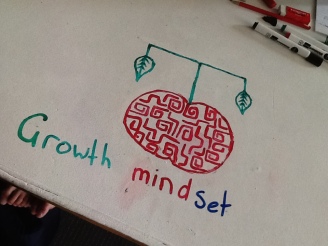Feeling the need to reflect on the what, why, and how of my classroom practice.
To clarify for myself what personalisation is, why I am doing it, and, to help move myself and others forward, HOW we do it.
Everything I read, watch, and listen to leads in the direction of personalising learning.
When personalisation is explained in a clear, simple, yet powerful way it becomes very obvious of its potential to not only engage our kids but EMPOWER them. Personalising learning is about handing the classroom back to the kids. It is about making learning about them rather than about us.
This post shared via Google+ today resonated HUGELY … I felt this could have been me writing this!
What is ‘personalising learning’ then?
It is co-constructing the environment and the learning with the kids so they are all learning at their own pace and finding success at their level in their time.


Why is ‘personalising learning’ the way forward?
Because it allows our learners a voice. Giving them a voice shows we care what they think. Giving them a voice is motivating and will lead to better engagement. Giving them a voice will means our kids will have opportunities to learn about things which are relevant, meaningful, and of interest to them. Personalising learning results in kids feeling success for the progress THEY have made.


How do we ‘personalise learning’?
At the heart of this working is the relationship you build with each learner AND, just as important, the culture you build in the classroom. Time needs to be spent getting to know each learner, showing you CARE about them, showing them you are interested in them and their stories, giving each one of them respect for who they are.


Once this is established (although keeping these relationships and culture throughout the year is essential and will require re-visiting everyday sometimes!), we need to take the time to show, model, demonstrate HOW our learners can self-regulate so they learn HOW to direct their own learning. As I have discovered, self-regulation is a complex notion involving a number of key skills the kids need to learn:
goal setting
planning
motivation
attention control/engagement
strategic thinking
self monitoring
help-seeking
metacognition/reflection/evaluating
The questions arise …
How do we give students a roadmap that provides them with these behaviours, skills, and structures that will help them self regulate?
How do we provide intervention strategies which help students set personal goals to move them towards individual agency as well as deal with the accountability that comes from the freedom to control their own learning plans?
I have developed a LearningMYway: Developing Agency rubric to help learners set their goals. Conferencing with the kids as to whether THEY think they are ‘Close-grained’ ‘Out in the Yard’ or ‘Free Range’. Helping learners set goals around agency keeps them focused on the skills of a 21 century learner.


All of this when students may be ready for varying degrees of agency at different times?
A major implication in helping students become self-regulative is the TIME required to teach students how to use specific strategies.
The time required will mean that fundamental changes at the school level will need to occur for teachers to be able to allocate the time and resources necessary for preparing students to be self-regulated learners.
Simply, our timetables will need to be flexible, we will often ‘stray’ from plans to make the most of the ‘just-in-time’ moments to shift learning, and most importantly – we must learn to have trust and faith in our kids that they CAN learn to direct themselves. It will take some longer to learn this than others but I have seen it work!
Something for people to remember however, personalising learning does not mean we let go of everything. It does not replace explicit instruction, structure, or standards. It means we provide an environment which allows our learners to direct as much of their learning as possible while we provide some structure around this at varying levels depending on the learner’s needs.


All of this is not easy!
A lot of the time this can be noisy, most of the time this can look messy, but ALL of the time it is aimed at developing learners who learn HOW to learn, who can make their own decisions, who are responsible for their own behaviour, and ultimately are achieving success through a self-directed learning plan they have created.
A Growth Mindset culture underpins ALL of this too. Without the understanding of this mindset learners default back to the way they have always done things … having to be TOLD!


It is about knowing the difference between the zoo tiger and the jungle tiger …

References
Bird, L. (2009). Developing self-regulated learning skills in young students (No. Ph. D.). Deakin University.
The skills agenda: Preparing students for the future. Retrieved June 4, 2015, from http://www.economistinsights.com/leadership-talent-education/opinion/skills-agenda-preparing-students-future
Yu, C. (2014 May 12). Student Agency http://www.knewton.com/blog/ed-tech-101/student-agency/ retrieved from http://www.knewton.com/
Zimmerman,B.J. (2011 November). Barry Zimmerman discusses self-regulated learning processes http://archive.sciencewatch.com/dr/erf/2011/11decerf/11decerfZimm/ retrieved from http://archive.sciencewatch.com/
Zumbrunn, S., Tadlock, J., & Roberts, E. D. (2011). Encouraging self-regulated learning in the classroom: A review of the literature. Metropolitan Educational Research Consortium (MERC).

Hi Kerri,
I LOVE the zoo and the jungle tiger analogy. What a great way to illustrate the difference between allowing students to learn based on their own strengths and skillsets vs. forcing students to learn in a “one-size fits all” classroom. I will be sharing this video with my peers in my online Masters of Education program.
My students and I are working toward becoming jungle tigers as I challenge them to set challenging goals and determine strategies to meet these goals. We have been talking about tracking our progress, but I never thought of using a rubric to show them if they are “Free Range” or “Close-grained” learners. I am definitely going to try a similar approach with my students! This would definitely help them with their goal setting (some of them initially chose goals that were very easy and would require little effort).
My question for you, is do you find that students have already been exposed to this mentality from their previous years in school? My students have never really done anything like this before entering my classroom, so they were a bit resistant at first. I’m wondering what it would be like to have students who have been exposed to this approach to learning for their entire schooling.
LikeLike
Kia ora Kerri. Another interesting read and thanks for sharing your thoughts. I’m on a similar pathway…but a few steps behind… Still looking for ways to encourage and sustain a similar approach with my crew. It’s a work in progress.
Your jungle vs zoo tiger is along the same lines as wolf vs lap dog that we’ve been looking at. I like the tiger analogy – might give that one a whirl too.
Ngā mihi. Jane (Mahana School)
LikeLike
Well Said Kerri! Your students will not only thrive now but in the future – the skills they learn as they navigate learning (and life) in your classroom will be essential to success as they head into the murky world of adulthood.
Thank you for sharing this post – hopefully other teachers will see the power of a learning environment such as this!!
LikeLiked by 1 person
Thanks for your thoughts Steph. The job now is to share with the community why we are changing pedagogy so they understand more and don’t see us as weird and not ‘teaching’ anything!
LikeLike
That is a fantastic post, Kerri. I love your rubric! Fantastic! One thing my y8s are reflecting on is how they prioritise tasks because they (actually we) are inclined to always spend hours and hours on the things we love/find easy even when other things are due sooner. We’ve talked to ppl in the workforce abt how the prioritise/plan their time. All about becoming more self-regulated and it’s super hard to do. I have kids who would spend their entire day doing 40bc the day before a science presentation. All good learning.
LikeLiked by 1 person
Hey Bridget… thanks for leaving a comment. I am in the process of ‘shortening up’ the rubric… too detailed as it us but it was fun coming up with the ‘proficiency’ level titles! Inspired by Claire Amos and her ‘free range’ definition:)
LikeLike
This is so on my wavelength. I did my MindLabEd literature review and planned the accompanying inquiry on self regulated learning. I believe this is the only way to think about successful personalised learning.
I will share my Google community that i started for a group of us working around similar topics in innovative learning practice.
I like the idea of the jungle tiger. Loving the parallel with my “tigger” status…loving that I will now think of myself as a jungle tigger rather than a zoo tigger.
LikeLiked by 1 person
Thanks for reading and replying Annemarie. It is very therapeutic writing reflections like this as it does clarify everything when sometimes I am questioning myself.
I would LOVE to join your Google Community … sharing with like-minded people is always inspiring. My colleague, Sandra, who is on the waka with me would be very keen too.
LikeLike